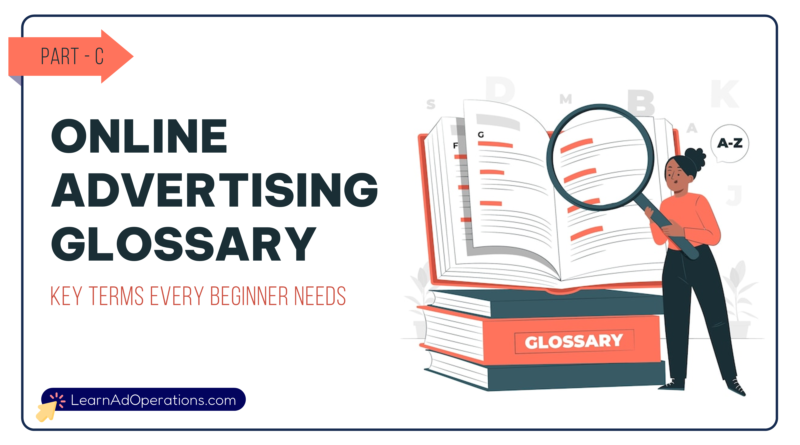Online Advertising Glossary for Beginners – Part 3
In the fast-evolving world of digital marketing, understanding online advertising jargon is essential for beginners who want to succeed. Our comprehensive Online Advertising Glossary for Beginners is the perfect resource to help you master critical digital advertising terms from A to Z.
Whether you’re diving into programmatic advertising, eCommerce advertising, performance marketing, or search engine marketing (SEM), this guide will empower you to quickly and effectively grasp the key concepts. By learning these terms, you’ll enhance your knowledge of digital advertising and improve your ability to develop successful digital marketing strategies.
Start exploring the intricate world of online ads and sharpen your marketing skills with our detailed glossary today!
C
Call to action (CTA): Any technique advertisers use to encourage consumers to respond promptly.
Campaign: A strategy for purchasing ad inventory driven by goals, or KPIs, that covers a set budget for a set period of time.
Category: Lists of keywords and phrases matched to content of webpages and apps.
Channel: The medium through which ads are served, which could include video ads, display ads, mobile ads, audio ads, and more.
Click: When a user interacts with an ad by clicking it.
Click ad fraud: Ad fraud that involves a party using a bot to repeatedly click an ad to generate money for a publisher that is paid per click.
Click retargeting: Targeting audience segments based on users that have clicked on creatives.
Click-through conversion: When a user clicks an ad and then converts via whatever is considered a conversion action, such as buying a product or performing a location lookup.
Are you looking to learn Online Advertising jargons? Here is the comprehensive online advertising glossary for beginners to learn digital marketing key terms from our Online Advertising Glossary.
Click-through rate (CTR): A ratio that divides the number of clicks by the number of ad impressions to show how often users who see an ad click on it.
Commitment: A non-guarantee agreement between advertisers and publishers in which advertisers agree to spend a certain amount of money during a campaign flight.
Companion banner: A display banner ad that is served alongside a video ad.
Completion rate: The percentage of ads served in an ad campaign that are viewed, played, or heard in their entirety.
Connected TV (CTV): A television or device that connects to the internet and enables users to stream TV programming on their television.
Consumer packaged goods (CPG): Products sold in sealed packages, such as food, beverages, and household items.
Content signals: Attributes, or metadata, applicable to all online video and audio content used to forecast, target, exclude, or optimize toward certain types of inventories.
Contextual categories: Categories that enable marketers to deliver relevant ads by matching identified keywords with the content of a website or an app, where an ad can potentially be placed.
Contextual targeting: A strategy that delivers relevant ads by matching identified keywords with the content of a website or an app, where an ad can potentially be placed.
Contract groups: A feature that enables marketers to group multiple private marketplace contracts and assign them across ad groups.
Conversion: The desired action a user takes after being exposed to an ad.
Conversion rate: The percentage of users that engage with an ad and complete an action, which is calculated by dividing the total number of conversions by the number of visitors to a website or media channel.
Cookie: A small file stored by websites on a web user’s computer to record data about the user’s browsing history.
Cookie mapping: The process of syncing cookies and sharing user IDs from one system to another.
Cookieless: Describes data collection options and audience-targeting methods that don’t rely on third-party cookies.
Cost per acquisition (CPA): A pricing model in which an advertiser pays a publisher based on the number of times users perform a specific action.
Cost per click (CPC): A pricing model where an advertiser pays publishers based on the number of times users click on an ad.
Cost per completed view (CPCV): A pricing model where advertisers pay publishers when users view a video ad in its entirety.
Cost per engagement (CPE): A pricing model where advertisers pay publishers each time a user engages with an ad.
Cost per install (CPI): A pricing model where advertisers pay publishers each time a user installs an application.
Cost per landing (CPL): A pricing model where advertisers pay publishers for each individual visit to the advertiser’s website.
Cost per Mille (CPM): A pricing model where advertisers pay publishers for every thousand ad impressions served.
Cost per point (CPP): A measure of cost-efficiency, typically for television advertising, that equals one rating point or 1 percent of the population in any geographically defined market.
Cost per view (CPV): A pricing model where advertisers pay every time users play or interact with a video ad.
Creative: The actual advertisement served to users to draw attention, communicate a message, or convert a visitor. Creatives can consist of text, images, video, audio, and animated elements.
Cross-device: A scenario in which users move and are converted through two or more devices.
Cross-device attribution: Enables advertisers to track the interactions a user has with an ad across multiple devices and properly credit conversions when users view an ad on one device but convert on another.
Cross-device targeting: Enables advertisers to scale high-value audiences across devices and environments, working in tandem with frequency capping to limit the number of times a user sees an ad across their devices.
CTV advertising: The process of serving video ads on internet-enabled TVs during TV programs.
CTV device: A device that connects a TV to the internet and enables access to content without the need for a cable subscription.
Customer data platform (CDP): A prebuilt system that centralizes customer data from all sources and makes this data available to other systems for marketing campaigns, customer service, and customer experience initiatives.
Customer relationship management (CRM): A technology that stores information a company has about their customers.
Competition Win %: The share of targeted impressions that a marketer wins in a programmatic market.
Consent Management Platform (CMP): Consent Management Platform (CMP) is a platform that is used by publishers for requesting, receiving, storing and updating users’ consent. CMPs usually employ a user-friendly interface to let users allow/disallow vendors to track, target, share their online footprint.
Consideration: Consideration advertising is a marketing goal designed to entice people to connect with a brand and learn more about its benefits.
Consumer: A consumer is a user browsing the internet, who sees and interacts with ads and who is looking to buy a product.
Cost of Sales (COS): The ratio between the total cost of the campaign and the sales that the campaign generated. In other words, your ad cost as a percentage of revenue. COS = Ad spend / Revenue driven
Source: The Trade Desk




